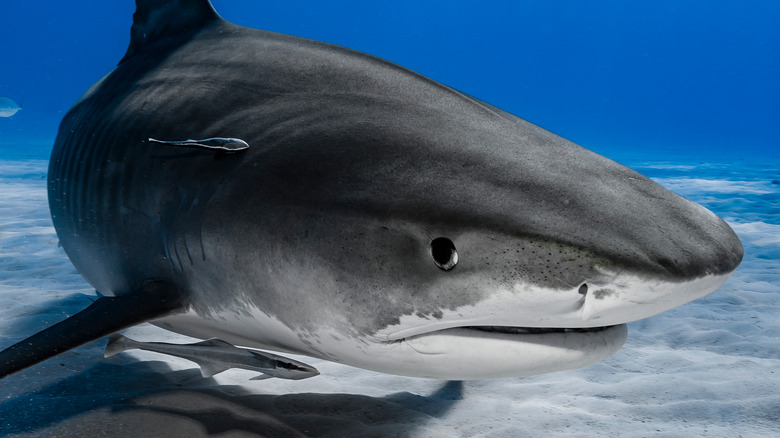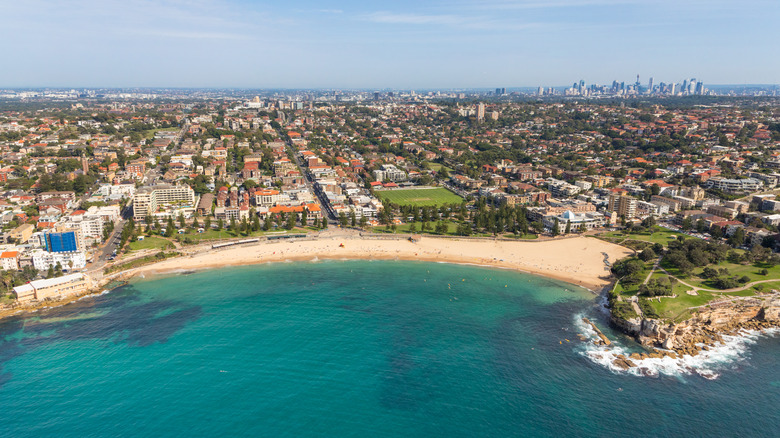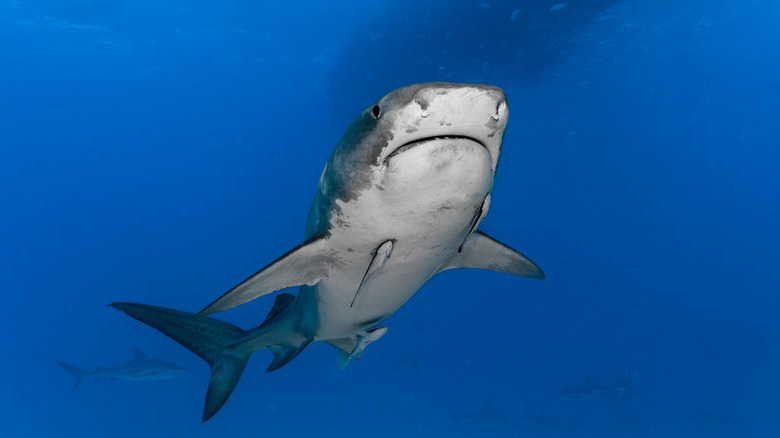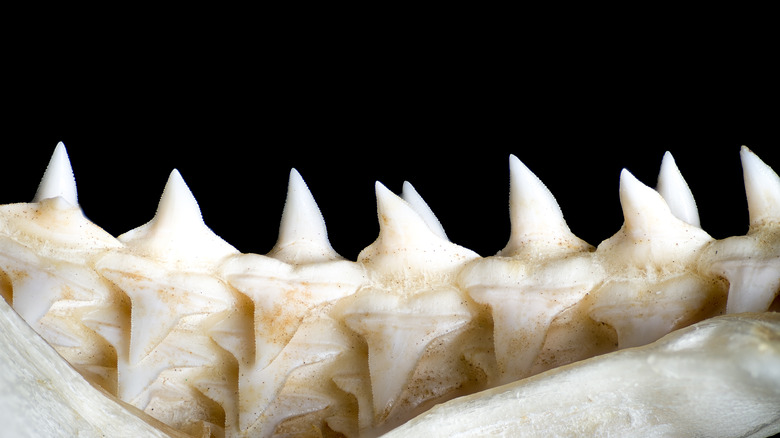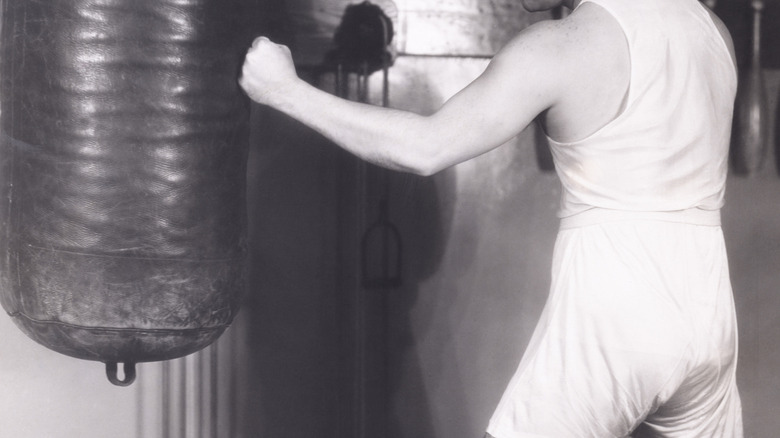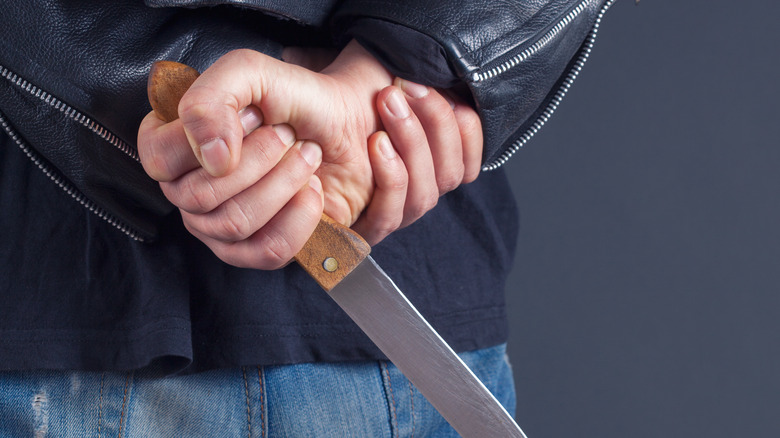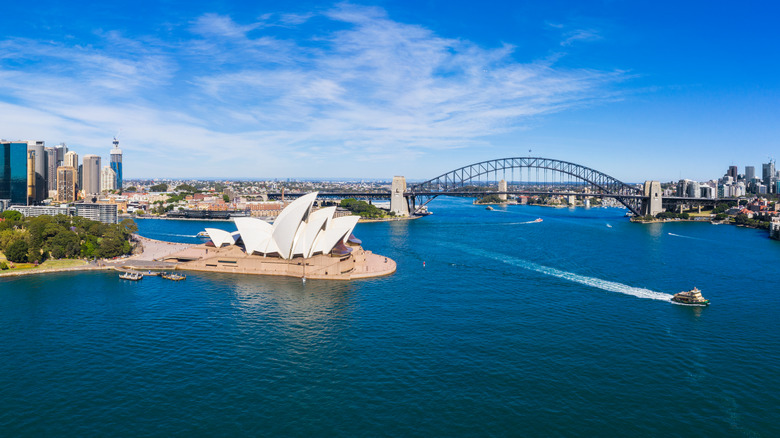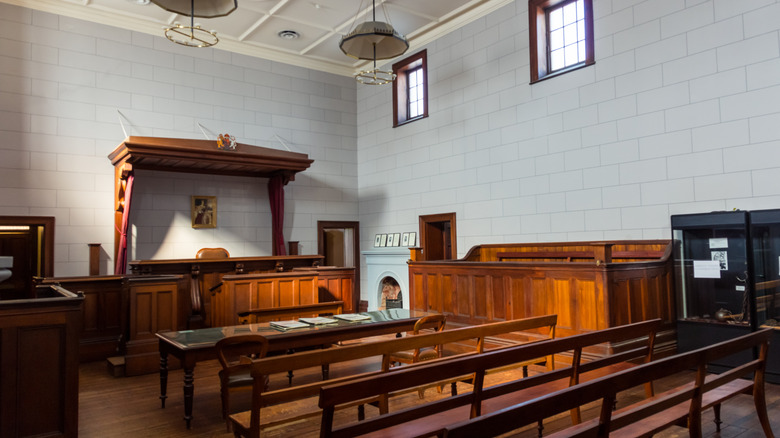The Strange Story Of The Shark Arm Case Murder
If a shark — a big shark — happened to vomit up a human arm, most people could do the math on the most likely way an arm could have ended up inside the aforementioned shark: First, the Shark in question must have bitten a person, removing and swallowing their arm in the process, then, secondly ... all right, so there really isn't even a secondly; that's probably all that happened.
That's what was initially thought to be the case in 1935 when a captive tiger shark in Australia did this very thing. However, it quickly became apparent that the arm hadn't been severed by the shark's teeth, and the piece of tiger shark throat debris led to a murder investigation, per the Dictionary of Sydney. It was eventually determined that the arm belonged to a man named Jimmy Smith, a former boxer who after leaving the ring became entangled with Australia's criminal underworld, according to an Australian commercial news site, news.com.au.
A shark is caught ... and then so is another one
It was mid-April in 1935, and a fisherman named Bert Hobson was throwing his line about three kilometers off of Coogee Beach, not too far from Sydney in southeast Australia, hoping for a big catch. According to Randwick City Council, Coogee Beach has calm waters thanks to an island known as Wedding Cake Island that protects it from aggressive surf. It was in those calm waters that the fisherman managed to hook a small shark. But as he was reeling in his catch, the fisherman got a first-hand glimpse at how the food chain works, as a larger tiger shark gulped down the small shark and was now on the hook.
The tiger shark the fisherman caught measured four meters (just over 13 feet), making it quite the impressive cartilaginous fish. Hobson decided not to release the shark, and with it still very much alive, he decided to bring it to the local Coogee Aquarium and Swimming Baths (via news.com.au), run by his brother, Charles (per Coogee Media). Upon seeing the new specimen, the aquarium-managing Hobson had dollar signs in his eyes.
Sharks were in the news, and not in a good way
The movie "Jaws" is the culprit for the modern shark hysteria that started in the 1970s. It was the beginning of an era when people feared a shark was swimming in their chlorinated pool. Still, shark attacks were grabbing headlines and striking fear into the hearts of swimmers years before Spielberg brought a killer shark to the big screen. In 1916, a string of four shark attacks in just two weeks horrified people along the New Jersey shore, and later inspired author Peter Benchley to write the novel "Jaws," which of course inspired the movie, per Smithsonian.
Around 20 years later, Australia was in the throes of an uptick in shark paranoia. Just in the two months before the Coogee beach tiger shark was caught, three men were killed at nearby beaches, per Dictionary of Sydney. Sharks were in the news, which meant Hobson's aquarium could tap into the interest in the animals and drum up some business.
According to news.com.au, Hobson's hunch was right, and for about a week after acquiring the tiger shark, people flooded the aquarium to get a glimpse of it. However, something bizarre happened on Anzac Day. It's a national holiday in Australia, roughly equivalent to Veterans Day in the United States. It also meant that Hobson's business was especially busy. It's been reported that at around 4:30 that afternoon the tiger shark started acting strangely, then it started vomiting. First came a rat and a bird, but then up came something infinitely more shocking and puzzling: a human arm.
The investigation begins, then immediately takes a turn
Police were called to the aquarium and were tasked with retrieving the severed arm from the tiger shark's tank; not exactly an enviable task, but they got it done. The arm was sent off to the medical examiner who made a discovery that managed to even out-shock the sight of a captive shark coughing up a human limb. According to the Dictionary of Sydney, they found the shark's teeth couldn't have been responsible for cutting off the arm and that it had to have been separated from a body by something especially sharp, like a knife or a similar instrument. It was now clear that whoever the victim was, they weren't the victim of a shark attack; they had been the victim of a murder.
It was estimated that the arm had been in the shark's stomach for anywhere from eight to 18 days. Yet, despite the highly acidic environment of a shark's stomach, there was still a clearly visible tattoo on the arm. The tattoo featured a pair of boxers in a ring.
Edwin Smith read about the arm in the newspaper, and it set off alarms in his head. He contacted the police and told them he thought that the arm in their possession could belong to his brother, Jimmy.
The life and times of Jimmy Smith
According to news.com.au, Jimmy Smith was born in England, but at the time of his death, he was living in Gladeville, a Sydney suburb. A local newspaper gave some background on Smith after it was confirmed that the arm was his. Smith had been a lightweight boxer, but at the time of his death he was managing a billiards hall, and it also mentioned that Smith was "a man with seemingly not an enemy in the world." That might not have been completely accurate. Smith didn't run with the best crowd. Several years earlier he was working as a builder and did a job for Reginald Holmes, a man known to be a key player in Australian crime. After that initial building job, Smith started working for Holmes in other capacities.
Smith started engaging in illegal activities that often involved boats, which makes some sense, as his primary cohort, Holmes, was himself a boat builder, per Atlas Obscura. Holmes worked in drug trafficking. Smith and another Holmes employee would use a speedboat to pick up cocaine dropped from ships. They then took the drugs to shore where they were sold in the city. Smith was also involved in an insurance scam that involved sinking a boat named Pathfinder. Eventually, another man named Patrick Brady came into the fold. He had been convicted of forgery in the past but continued using that skill in a series of scams with Holmes and Smith.
The death of Jimmy Smith
At some point, Smith and Holmes had a falling out. According to Atlas Obscura, investigators later surmised that this could have been the result of a bungled scam. The last time Jimmy Smith was seen alive was April 7, when he was spotted drinking with his literal partner in crime, Patrick Brady. They were seen playing dominoes at a hotel outside of Sydney, but they eventually left and didn't return to the hotel.
Unfortunately, when it came up that Smith was missing and was thought to have been murdered, those who had seen them on April 7 quickly pointed police in Brady's direction. It turns out that on the night he and Smith were out drinking, Brady had rented a nearby cottage, and according to news.com.au, it's generally thought that the murder occurred in the cottage. To make matters worse for Brady, a taxi driver remembered giving him a lift to Reginald Holmes' house not long after investigators seemed to think the murder took place.
According to Atlas Obscura, there was enough to start questioning Brady and Holmes. Neither one was cooperative, but Holmes managed to be released by saying he didn't know Brady, who wound up being charged with Smith's murder.
The death of Reginald Holmes
A few days after being questioned about Jimmy Smith's death, Reginald Holmes took one of his boats out on the water early in the morning. With him was a bottle of brandy and a small handgun. Apparently, according to news.com.au, Holmes got heavily intoxicated and then attempted to shoot himself. Oddly enough, the bullet hit Holmes in the forehead, and the force knocked him overboard into the water, but didn't kill him. He eventually regained consciousness, hopped back in his boat, and began speeding erratically toward the busy Sydney Harbour where police spotted and arrested him.
Police wanted more information as to what would drive Holmes to attempt suicide, and he argued that Brady had shown up at his house the night of the murder, brandishing the severed arm of Jimmy Smith. Brady tried to extort money from Holmes by threatening to pin the murder on him. Holmes alleged that Brady had been solely responsible for killing Smith, dismembering his corpse, and throwing the pieces into the ocean, which criminals of the era referred to as a Sydney send-off. However, Holmes alleged that Brady left the arm at his house, and while he maintained he wasn't involved in the murder, he claimed to have thrown the arm into the water. Police asked Holmes to be a witness at an upcoming inquest related to the murder, and he agreed. But on the morning of the inquest, Holmes was found in his car, dead from three gunshot wounds (via Dictionary of Sydney).
The case draws to an open-ended close
According to news.com.au, there were two prevailing theories as to how and why Holmes was killed. While the truth was never determined, one of the explanations makes a lot of sense while the other seems so outlandish that calling it "ludicrous" is not quite a strong enough word. Let's start with the latter.
The first theory was that Holmes had hired a hitman ... to kill himself. It's especially odd considering Holmes had already survived one suicide attempt, but perhaps he had been scarred by his initial attempt and thought having someone else pull the trigger would be easier. Still, most people would consider this fairly outlandish. The second theory — which while unproven, sounds far more plausible — was that Brady used his criminal connections to order Holmes' murder from inside his prison cell. The knock-on effect here was that with Holmes dead and thereby unable to appear at the inquest, Brady was released.
As if those weren't enough twists and turns, there was still one more to come: It eventually came out that Smith might have been a fizzer or fizgig, slang terms for a police informant, per Dictionary of Sydney. No one was ever charged with the murder of Jimmy Smith. The captive shark was cut open in a search for more evidence, but came up empty (of evidence, anyway). Until his death in 1965, Brady maintained that he had absolutely nothing to do with the bizarre, grisly crime.
